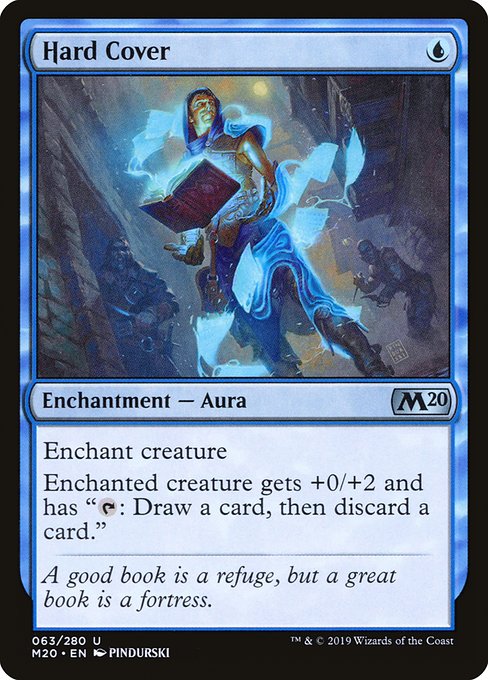
Image courtesy of Scryfall.com
Mapping Blue Auras: A Network Graph Perspective on Hard Cover
Blue does not always grab the loudest headlines in a battlecruiser meta, but when it buffets the battlefield with smart control and subtle card advantage, it earns a quiet kind of respect. Hard Cover—an uncommon aura from Core Set 2020—embodies that disciplined blue ethos. For a single blue mana, you cast an enchantment aura that attaches to a creature and quietly reshapes the value of the board: the enchanted creature swings with a +0/+2 boost, and more importantly, gains a usable ability: Tap: Draw a card, then discard a card. It’s a card that rewards careful sequencing, weaving a small, steady thread of card advantage into the fabric of your blue deck. 🧙♂️🔥💎
When we talk about a network graph of MTG card relationships, Hard Cover is a terrific case study. In a graph, we think of cards as nodes and the interactions between them as edges. On one axis you have the color identity and mana curve; on another, you have mechanics like Enchant, Tap abilities, and card draw. Hard Cover sits at the crossroads of these axes: blue mana, an Aura that enchants, and a draw/discard engine activated by tapping the enchanted creature. The result is a compact, repeatable engine that scales with the game state, especially in longer matches where blue’s tempo control can stall for times to set up the advantage. 💬
What makes Hard Cover a well-connected node
- Enchantment — Aura DNA: As an Aura with Enchant creature, it naturally edges toward other aura-friendly strategies. Cards like Oppressive Aura or Pacifism-type effects share a conceptual space, while Hard Cover’s own ability creates a draw engine that blue decks crave in the late game.
- Blue Card Draw, Deliberate Pace: The activated ability taps into the classic blue motif of card advantage. It’s not a one-shot bolt; it’s a rinse-and-repeat engine that scales with board presence and hand size, reinforcing the graph edge to draw-spell archetypes and looting effects.
- Mana Cost and Set Context: With a low mana cost of {U} from Core Set 2020, it sits in early to mid-game play ~a perfect connector between cheap auras and early defensive plays. The M20 frame anchors it in a time when blue decks experimented with new ways to leverage card advantage under tempo pressure.
- Flavor and Theme Pairing: The flavor text—“A good book is a refuge, but a great book is a fortress.”—is poetic software for a graph, hinting at a strategic fortress built with knowledge and timing. This narrative layer links the card to other literature-tinged blue staples and helps players remember why it’s not just a stat-line snippet but a coherent piece of a deck’s story arc. 🧭
In practical terms, Hard Cover plays nicely with other card draw engines. It can dovetail with cantrips and Filter/Surf spells that blue players love, enabling you to sculpt your next draw step as a deliberate choice rather than a random event. The aura’s buff to a creature’s power and the potential to draw a card on tap can force an opponent to respond—either by removing the aura or by committing blockers—creating edges that ripple through the rest of the board. This is the kind of relationship that a network graph reveals in vivid color: a subtle but persistent loop of advantage that grows with each passing turn. 🎲
“A good book is a refuge, but a great book is a fortress.” That line from Hard Cover’s flavor text captures the strategic vibe of this card: in the right hands, it becomes a bastion of card draw and a shield for your plan. 🔥
Artistically, PINDURSKI’s illustration gives the card a calm, scholarly aura. The image embodies the idea of knowledge as protection, a fitting metaphor for blue’s patient, plan-ahead approach to combat. The artwork plus the card’s bake-in resilience signals that Hard Cover is less about flashy combos and more about dependable synergy—an anchor card around which thoughtful blue decks can orbit. For collectors, the card’s rarity (uncommon) and its presence in both foil and nonfoil printings add a modest but real layer of surface value, while its EDH/Commander foothold remains modest but genuine. The market data shows a classic blue rail card: affordable to pick up, with foil versions giving a small premium. As of current data, uncommons like this are accessible, with nonfoil around a few cents and foil a bit more, making it a practical historical artifact for blue-light enthusiasts. 🧠💡
Connecting to the wider MTG ecosystem
Graph theory isn’t just a math exercise; it’s a way to visualize how a single card travels through formats, decks, and gameplay moments. Hard Cover’s edges point toward a family of blue enchanters and card-draw mechanics—think of it as a node that helps illuminate how blue’s tempo and value engines weave together in the modern era. In formats like Modern, Eternal, and Commander, even an understated aura can become a persistent thorn in the side of aggro strategies or a measured tempo play against control. The network graph helps players and designers alike appreciate how even the smallest card can influence deck construction, mulligan decisions, and the long arc of a game. 🧙♂️⚔️
For readers who enjoy the broader arc of MTG design and culture, the five links at the end of this piece offer a spectrum of related conversations—from digital-age paper crafting and cohesive aesthetic themes to metagame forecasts and the conversion of paper concepts to pixels. For a tactile counterpoint to all this, consider how a modern accessory, like Neon Tough Phone Case 2-Piece Armor for iPhone Samsung, keeps your gear safe while you draft—because card strategy and real-world accessories both reward thoughtful design. 🧙♂️🎨
Neon Tough Phone Case 2-Piece Armor for iPhone SamsungMore from our network
- https://transparent-paper.shop/blog/post/paper-crafting-in-the-digital-age-a-modern-revival/
- https://crypto-acolytes.xyz/blog/post/silent-blue-white-giant-maps-milky-way-gravity/
- https://transparent-paper.shop/blog/post/designing-digital-planners-with-cohesive-aesthetic-themes/
- https://blog.rusty-articles.xyz/blog/post/metagame-forecast-grow-from-the-ashes-post-release/
- https://blog.rusty-articles.xyz/blog/post/from-paper-to-pixels-mtgs-your-wish-is-my-command/